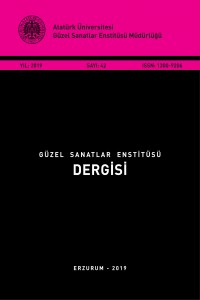Abstract
Since the beginning of the twentieth century, while it
can be clearly observed that mass production gained a great deal of momentum
parallel to the development of industry and technology, the objects of daily
use that started to surround the living space, have also started to become the
subject and material which the artists have dealt with intensively in their
works.
The aim of this study is to focus on how the objects, which
are transformed from being an everyday object of use, to an object of art by
the artist’s choice, acquired an effective role in the rearrangement other than
their production purposes and the realization of works of art with their new
contexts. In this study, the necessary references had been reviewed about what
kind of understanding evoked in the field of art by the goods produced for
everyday use with their changing realities and a chronological order was
followed considering the changes in the process starting from the first
examples in the field of art until today. Therefore, considering the
transformation of objects of everyday use relative to vital, temporal etc.
conditions, it shows how important and unavoidable it is that they continue to
be used as an instrument in the transfer of artistic thought today.
Keywords
References
- Antmen, A. (2012). 20. Yüzyıl Batı Sanatında Akımlar. İstanbul: Sel Yayıncılık.
- Atakan, N. (2008). Sanatta alternatif arayışlar (Z. Rona, Çev.). İzmir: Karakalem Kitabevi.
- Baudrillard, J. (2011). Nesneler sistemi (O. Adanır ve A. Karamollaoğlu, Çev.). İstanbul: Boğaziçi Baudrillard, J. (2014). Sanat komplosu (I. Ergüden, Çev.). İstanbul: İletişim Yayınları.
- Bilgin, N. (2011). Eşya ve insan. İstanbul: Gündoğan Yayınları.
- Danto. A. (2013). Sanat nedir? (Z. Baransel, Çev.). İstanbul: Sel Yayıncılık.
- Draaisma, D. (2014). Bellek metaforları (G. Koca, Çev.). İstanbul: Metis Yayınları.
- Eşya. (t.y.). Türk dil kurumu güncel Türkçe sözlüğü. Erişim adresi: http://tdk.gov.tr/index.php?option=com_gts&arama=gts&guid=TDK.GTS.5c7252ef858196.91901182
- Foster, H. (2009). Gerçekliğin geri dönüşü (E. Hoşsucu, Çev.). İstanbul: Ayrıntı Yayınları.
- Kahraman, H. B. (2002). Sanatsal gerçeklikler, olgular ve öteleri. İstanbul: Everest Yayınları.
- Lazzarato M. (2017). Marcel Duchamp ve işin reddi (S. Çalcı, Çev.). İstanbul: Kolektif Kitap.
- Merleau-Ponty, M. (2010). Algılanan dünya (Ö. Aygün, Çev.). İstanbul: Metis Yayınları.
Abstract
20.
yüzyılın başından itibaren endüstri ve teknolojinin gelişmesine paralel seri
üretimlerin hız kazandığı açıkça gözlemlenirken, insanın yaşantısını sürdürdüğü
çevreyi daha çok kuşatmaya başlayan günlük kullanım nesneleri, sanat alanında
da sanatçıların, çalışmalarında yoğunluklu olarak ele aldığı konu ve malzeme
haline gelmeye başlamıştır.
Bu araştırmanın amacı sanatçıların seçimiyle
kullanım nesnesi olmaktan sanat nesnesine dönüşmeye başlayan nesnelerin üretim
amaçları dışında yeniden düzenlenmesi ve taşındıkları yeni bağlamlarıyla
sanatsal çalışmaların gerçekleştirilmesinde nasıl etkin bir role kavuştuğu
üzerine yoğunlaşmaktadır. Bu çalışmada gündelik kullanım için üretilen
eşyaların değişen gerçeklikleriyle birlikte sanat alanında ne türden bir kavrayışa
neden olduğuna yönelik gerekli kaynak taraması yapılmış, sanat alanındaki ilk
örneklerinden başlayarak günümüze kadar uzanan süreçte yaşanan değişimler göz
önünde bulundurularak kronolojik bir sıralama izlenmiştir. Dolayısıyla günlük kullanım
nesnelerinin yaşamsal, zamansal vb. koşullara bağlı olarak gösterdiği değişimler
göz önüne alındığında bugünde sanatsal düşüncenin aktarılmasında bir aracı
olarak kullanılmaya devam etmelerinin ne derece önemli ve kaçınılmaz olduğunu ortaya
koymaktadır.
Keywords
References
- Antmen, A. (2012). 20. Yüzyıl Batı Sanatında Akımlar. İstanbul: Sel Yayıncılık.
- Atakan, N. (2008). Sanatta alternatif arayışlar (Z. Rona, Çev.). İzmir: Karakalem Kitabevi.
- Baudrillard, J. (2011). Nesneler sistemi (O. Adanır ve A. Karamollaoğlu, Çev.). İstanbul: Boğaziçi Baudrillard, J. (2014). Sanat komplosu (I. Ergüden, Çev.). İstanbul: İletişim Yayınları.
- Bilgin, N. (2011). Eşya ve insan. İstanbul: Gündoğan Yayınları.
- Danto. A. (2013). Sanat nedir? (Z. Baransel, Çev.). İstanbul: Sel Yayıncılık.
- Draaisma, D. (2014). Bellek metaforları (G. Koca, Çev.). İstanbul: Metis Yayınları.
- Eşya. (t.y.). Türk dil kurumu güncel Türkçe sözlüğü. Erişim adresi: http://tdk.gov.tr/index.php?option=com_gts&arama=gts&guid=TDK.GTS.5c7252ef858196.91901182
- Foster, H. (2009). Gerçekliğin geri dönüşü (E. Hoşsucu, Çev.). İstanbul: Ayrıntı Yayınları.
- Kahraman, H. B. (2002). Sanatsal gerçeklikler, olgular ve öteleri. İstanbul: Everest Yayınları.
- Lazzarato M. (2017). Marcel Duchamp ve işin reddi (S. Çalcı, Çev.). İstanbul: Kolektif Kitap.
- Merleau-Ponty, M. (2010). Algılanan dünya (Ö. Aygün, Çev.). İstanbul: Metis Yayınları.
Details
| Primary Language | Turkish |
|---|---|
| Journal Section | Research Article |
| Authors | |
| Publication Date | March 26, 2019 |
| Submission Date | November 14, 2018 |
| Published in Issue | Year 2019 Issue: 42 |
Obtaining permissions for studies requiring ethics committee approval regarding the implementation of ethical rules and including information about permission in the article was added to the criteria. In this direction, Ethics Committee Permission is required for articles submitted to our journal and meeting the conditions stated below.
• Any research conducted with qualitative or quantitative approaches that require data collection from participants using questionnaires, interviews, focus group work, observation, experimentation, and interview techniques.
Also;
• Obtaining and indicating permission from the owners for the use of scales, surveys and photographs belonging to others,
• It should be stated that the copyright regulations are complied with for the intellectual and artistic works used.

